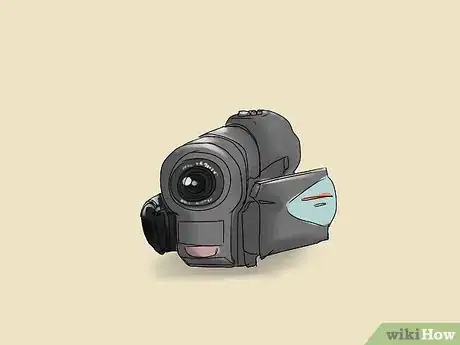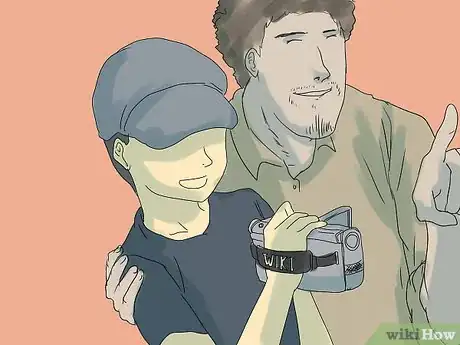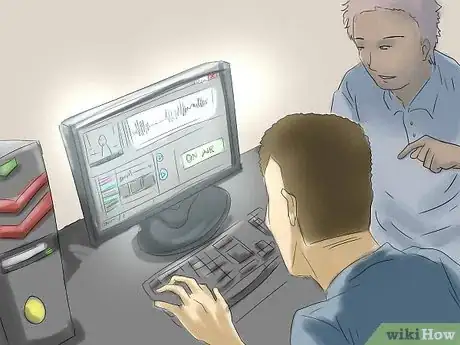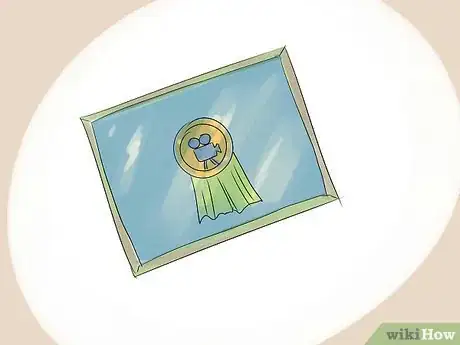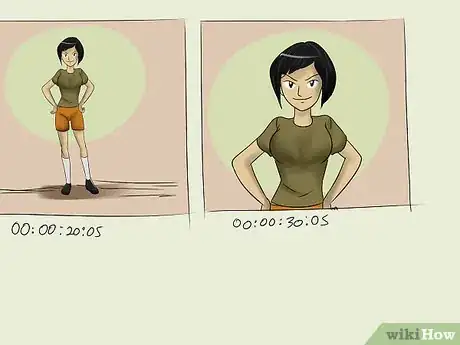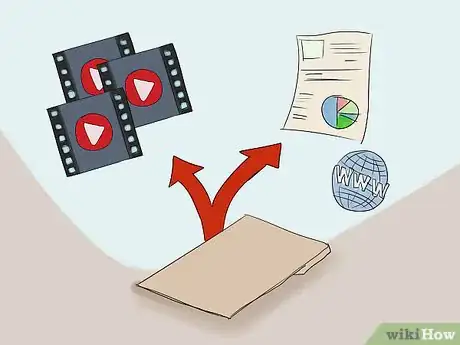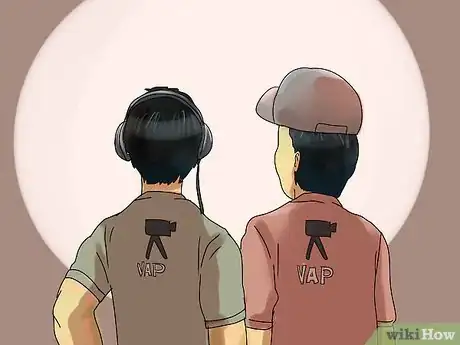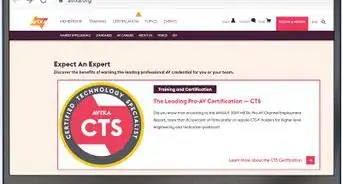This article was co-authored by Heather Gallagher. Heather Gallagher is a Photojournalist & Photographer based in Austin, Texas. She runs her own photography studio named "Heather Gallagher Photography" which was voted Austin's Best Family Photographer and top 3 Birth Photographers in 2017, 2018, and 2019. Heather specializes in family Photojournalism and has over 15 years of experience documenting individuals, families, and businesses all over the world. Her clients include Delta Airlines, Oracle, Texas Monthly, and her work has been featured in The Washington Post and The Austin American Statesman. She is a member of the International Association of Professional Birth Photographers (IAPBP).
There are 30 references cited in this article, which can be found at the bottom of the page.
This article has been viewed 67,981 times.
Videography is a competitive field that requires ambition, technical knowledge, and creativity. You can prepare to become a videographer by getting the right education and experience under your belt. Once you enter the field, you can work on finding jobs, building a portfolio, and developing a unique style. Videographers look for careers with movie studios and directors, television stations, news agencies and other media companies, with universities, courts, and other public institutions, as social media consultants, or documenting events such as weddings.
Steps
Developing Your Skills and Career
-
1Learn everything you can about video equipment and software.[1] As a videographer, you will constantly be working with camera equipment and editing software, so it’s a good idea to start practicing with these right away. While digital cameras and computer software are the state of the art, you might also gain some familiarity with other types of equipment and editing techniques.
- Get a digital camera and start filming whatever you find interesting. Using a computer and at least basic software, start learning how to edit your footage. Even if you just keep it for yourself, this will be good practice.
- Professional video equipment and software can be expensive, but if you are serious about becoming a videographer, it might be worth the investment.
-
2Look for internships or apprenticeships. On the job training is important for many videographers.[2] [3] Some crews use specialized software and equipment, and this training is meant to increase your familiarity with it. The skills you learn as an intern or apprentice, however, can be used later on in your career.
- Check with school film and broadcasting departments about possible internships.
- You can also contact television companies, film studios, and related groups directly about completing an internship. Some may have programs already in place that you can apply for.
Advertisement -
3Take workshops. Film and video production and editing is always changing. To keep up with developments, consider taking workshops and courses at colleges and universities, film schools, and other institutions. Even if you already have an educational background in videography and experience in the field, these workshops can refresh your knowledge and make you aware of new things to try so that you keep up with the state of the art.
-
4Consider getting a college degree. While you don’t necessarily need a specific degree in order to work as a videographer, most individuals in the field have a bachelor’s degree in some area that is related to film or broadcasting.[4] [5] While earning a degree, you will gain valuable technical skills and experiences. Course you can take (and potential majors) include:
- Communications
- Cinematography
- Broadcasting
- Video editing
- Film theory
- Computer science[6]
- Script analysis
- Media ethics
- Screenwriting
-
5
-
6Become certified, if desired. There is no widely-accepted certification for videographers.[9] However, you can seek out any certifications, specializations (such as legal video or digital video editing) or courses that look attractive to you and might bolster your resume.[10] Prepare for these by taking a class, studying on your own, and taking any required examinations.[11]
Filming and Editing
-
1Plan before shooting.[12] Spend some time sketching out your ideas before you film any subject. You can draw or write out a rough storyboard of what you want to film, and use this as a guide. You can edit and change things later, but having a plan helps you work efficiently and produce great results.
- If you need special equipment or assistants for a project, make sure they are prepared beforehand. This will save you time and money.
-
2Practice taking different kinds of shots. Videography is an art that involves much more that simply pointing a camera at something and shooting. By taking different kinds of shots, you can vary your work with a subject, making your footage more interesting and compelling to viewers.
- The extreme long shot (ELS) or extreme wide shot (EWS) covers a very wide area, placing your subject in context.[13] For instance, if you are filming a wedding, you might include an EWS that shows the entire wedding party and audience, with the couple at the center.
- A long shot (LS), full shot (FS), or wide shot (WS) captures the entire subject within the camera frame.[14] [15] For instance, if you are recording a speaker, a FS will show the figure filling the screen, from head to toe.
- A medium long shot (MLS) or medium wide shot (MWS) or three-quarter shot is often used for filming people, and shows a subject from about the knees up.[16] [17] This kind of shot is useful for recording small groups of people, such as a group of bridesmaids chatting at a wedding.
- The medium shot (MS) shows individuals from the waist up.[18] [19] It focuses the viewer’s attention on the subject, and is useful for filming interviews. It is useful for showing detail when filming other subjects.[20]
- The medium close-up (MCS) shows a figure’s shoulders and head.[21] It is used for filming interviews and in contexts like news studios.
- The close up (CU) fills the camera’s frame with the subject.[22] [23] It is useful for capturing emotion and facial expressions.
- The extreme close up (ECU) films just a part of a subject, such as a person's eyes.[24] It can be used for very dramatic effects.
-
3Utilize different camera moves.[25] A stationary camera pointed at a single subject can be simple and effective, but it can also get a little boring. To vary your projects and make them more interesting, try moving your camera in several ways, including:
- Panning, which involves turning the camera from left to right or right to left. This is useful, for instance, when filming a crowd or landscape.
- Tilting, which means moving the camera up or down to show parts of a subject that were off-screen. This move is useful when filming subjects like close-ups of people or buildings.
- Trucking and dollying, which involve physically moving a camera around or away from a subject, respectively. For instance, if you are filming a small group of people, you can truck a camera around the perimeter of the group to capture it from many angles. Likewise, if you want to film a sense of leaving a subject, like a building, dolly a camera pointed at the building away from it.
-
4Incorporate a variety of camera techniques. You can create additional variety by utilizing special analog and digital effects. Some of these can be used while filming, while others can be added during editing. Common techniques include:[26]
- Zooming in and out
- Fading in and out
- Cutting (shifting the film from quickly one scene to another, such as from a shot of a bride with bridesmaids inside a church to a shot of the church viewed from the outside).
- Transitions (shifting between scenes more subtly, such as fading out on a shot of a bride to a new shot of a church)
-
5Practice using the “wide, medium, tight” method.[27] This technique is a proven one to help you get good footage of many different kinds of subjects. It focuses on capturing a subject from several different angles to create variety. You can then arrange the clips during the editing phase in whatever order seems good to you.
- Get one wide shot of a subject. For instance, when filming a speaker in front of a crowd, get a shot that shows the speaker as well as the whole crowd.
- Take a medium shot of the subject. For instance, you could zoom in on the speaker to show a stage and podium.
- Incorporate one close-up (“tight”) shot. For instance, get a close-up shot of the speaker’s face during a particularly emotional or important moment.
- Make sure to hold each shot for at least ten seconds. You can remove sections you don't need during editing, but you can’t add them if you never filmed them in the first place.
-
6Experiment with editing.[28] Utilizing the software and equipment that you have, try arranging your raw footage in various ways for practice. There are many different ways to edit film, and it’s really up to you to find a unique style, so feel free to experiment. For instance:
- Edit a series of different shots together to create a story or narrative.
- Practice adding sound, text, and other elements to create interest and variety.
- Utilize digital effects to alter your footage.
- Incorporate different types of transitions, such as fades, wipes, and dissolves.
-
7Be creative. Videographers are first and foremost artists, so don’t neglect your creative side.[29] Pay attention to the work of other videographers whose work you admire, but also take the time to practice any other arts that interest you (music, painting, literature, etc.), and to read widely and learn about lots of different things . In addition, set aside regular sessions to brainstorm ideas by sketching, writing, or using software. All of this can boost your creativity and success as a videographer.
Gaining Experience
-
1Build a portfolio.[30] Once you have started producing some strong, edited video footage, you should assemble a portfolio of your best work. Include clips or full footage that you have shot, whether as a student, for a project, or as part of a job. Show this portfolio to studios, producers, and others you approach when looking for jobs.
- Include lots of different clips of things that you have shot and edited.
- If you want to show that you are a diverse videographer, make sure that your portfolio shares clips a variety of subjects.
- If you want to concentrate on a certain type of videography, such as for weddings, then make sure that your portfolio has a range of different clips from weddings you have filmed.
- Make sure to include clips of varying lengths. Some prospective clients might want to see 30 minutes of that wedding that you shot, while others might only have time to look at a 30-second clip.
- Create a website or channel on a video-sharing website to showcase your work. You can share the link to your portfolio, promote it on social media, etc.
- It is a good idea to have your portfolio in several formats. For instance, you might also create DVDs with samples of your best work to show to clients or job search committees that prefer that format.
- Make sure your portfolio evolves, even after you have worked as a videographer for some time. Keep adding superior work, and remove any that seems outdated, irrelevant, or not as good.
-
2Join a professional organization. Professional organizations and associations are great ways to find out more about the field, to network with colleagues, and to learn about jobs and other opportunities. Some videography associations are regionally-based.[31] [32] Others focus on a certain type of videography practice (such as weddings or university projects).[33] [34] Professional organizations you might consider joining include ones like:
- The New England Professional Videographers Association (NPVA)
- The Bay Area Professional Videographers Association (BAPV)[35]
- The Minnesota Professional Videographers Association (MPVA)[36]
- The Colorado Professional Videographers Association (CPVA)[37]
- The Michigan Video Association (MIVA)
- The Wedding and Event Videographers Association International (WEVA)[38]
- The University Film and Video Association (UFVA)[39]
- The American Guild of Court Videographers (AGCV)[40]
-
3Attend conferences and professional meetings. Conferences are a great way to expand your knowledge and contacts in the field. You can attend panels and presentations to hear about new developments, equipment, and techniques in the field, as well as network with colleagues and learn about job opportunities. Many professional videographer associations host regular conferences you can attend.[41] [42]
-
4Look for jobs. Jobs for videographers will typically depend on experience and past projects, so don’t be surprised if things start out slow. Focus on making an excellent portfolio, assembling a good client list, and crafting a strong resume. Many videographers are self employed, gaining experience and making a name for themselves client by client.[43] Other places that videographers find jobs include cable and television networks, film studios, and news organizations.[44]
- Some calls for videographers will be posted to general jobs boards, such as Indeed and Monster.
- If you are looking to work as a videographer for specific types of institutions, such as courts or universities, you should also check their websites for possible job postings.
- Some professional associations for videographers may post jobs, host job fairs, workshops on finding jobs, networking events, etc.
- Freelance videographers typically concentrate on finding jobs by word of mouth referrals, and by marketing their services.
-
5Utilize social media to create a brand for yourself. Using social media to advertise your company or services as a videographer is key to getting clients. If you are working as a freelance or self-employed videographer, it is critical to use social media to advertise your work and attract potential clients.
- Create a profile on a variety of social media sites. For videographers, this includes sites that focus on video content (like YouTube and Vimeo) as well as other networking sites (such as Facebook, Twitter, LinkedIn, Pinterest, Instagram, Google Plus, etc.).
- Make sure that your profile is public, if it is associated with your own name instead of a brand or company name.
- Post regularly, including samples of your own work. You could share a "clip of the week," for instance.
- Mention clients in your posts. If they provide you with positive reviews, ask if you can share the feedback online.
- Network with other videographers and other individuals in your field by following and commenting on their profile pages.
- Share or repost any information you think clients might be interested in.
-
6Explore alternative careers.[45] Not every person that is trained as a videographer becomes one, or remains one forever. Videographers can find rewarding careers in related fields, including:
- Broadcasting
- Sound engineering
- Video or film production
Expert Q&A
-
QuestionHow do videographers get clients?
 Heather GallagherHeather Gallagher is a Photojournalist & Photographer based in Austin, Texas. She runs her own photography studio named "Heather Gallagher Photography" which was voted Austin's Best Family Photographer and top 3 Birth Photographers in 2017, 2018, and 2019. Heather specializes in family Photojournalism and has over 15 years of experience documenting individuals, families, and businesses all over the world. Her clients include Delta Airlines, Oracle, Texas Monthly, and her work has been featured in The Washington Post and The Austin American Statesman. She is a member of the International Association of Professional Birth Photographers (IAPBP).
Heather GallagherHeather Gallagher is a Photojournalist & Photographer based in Austin, Texas. She runs her own photography studio named "Heather Gallagher Photography" which was voted Austin's Best Family Photographer and top 3 Birth Photographers in 2017, 2018, and 2019. Heather specializes in family Photojournalism and has over 15 years of experience documenting individuals, families, and businesses all over the world. Her clients include Delta Airlines, Oracle, Texas Monthly, and her work has been featured in The Washington Post and The Austin American Statesman. She is a member of the International Association of Professional Birth Photographers (IAPBP).
Media Specialist Offer your services for free to friends and family members when you're first starting out to gain some experience.
Offer your services for free to friends and family members when you're first starting out to gain some experience. -
QuestionWhat's the average salary for a videographer?
 Community AnswerIn the US, the average salary for a videographer is about $62,000 (as of March 2018).
Community AnswerIn the US, the average salary for a videographer is about $62,000 (as of March 2018).
References
- ↑ http://www.bls.gov/ooh/media-and-communication/film-and-video-editors-and-camera-operators.htm#tab-4
- ↑ http://learn.org/articles/What_Type_of_Education_and_Training_is_Needed_for_Becoming_a_Video_Editor.html
- ↑ http://www.bls.gov/ooh/media-and-communication/film-and-video-editors-and-camera-operators.htm#tab-4
- ↑ http://www.bls.gov/ooh/media-and-communication/film-and-video-editors-and-camera-operators.htm#tab-4
- ↑ http://learn.org/articles/What_Type_of_Education_and_Training_is_Needed_for_Becoming_a_Video_Editor.html
- ↑ http://learn.org/articles/Video_Editing_5_Steps_to_Becoming_a_Video_Editor.html
- ↑ http://www.videoawards.com/
- ↑ http://bapva.org/
- ↑ http://learn.org/articles/What_Type_of_Education_and_Training_is_Needed_for_Becoming_a_Video_Editor.html
- ↑ http://www.tri-c.edu/programs/media-arts-and-studies/digital-video-editing-certificate.html
- ↑ http://www.bls.gov/ooh/media-and-communication/film-and-video-editors-and-camera-operators.htm#tab-4
- ↑ https://www.asu.edu/alti/ltlab/tutorials/video/basics/index.htm
- ↑ https://www.asu.edu/alti/ltlab/tutorials/video/basics/type1_els.htm
- ↑ https://www.asu.edu/alti/ltlab/tutorials/video/basics/type2_ls.htm
- ↑ http://zimmer.csufresno.edu/~candace/basics/shooting.htm
- ↑ https://www.asu.edu/alti/ltlab/tutorials/video/basics/type3_mls.htm
- ↑ http://zimmer.csufresno.edu/~candace/basics/shooting.htm
- ↑ https://www.asu.edu/alti/ltlab/tutorials/video/basics/type4_ms.htm
- ↑ http://zimmer.csufresno.edu/~candace/basics/shooting.htm
- ↑ http://zimmer.csufresno.edu/~candace/basics/shooting.htm
- ↑ https://www.asu.edu/alti/ltlab/tutorials/video/basics/type5_mcu.htm
- ↑ https://www.asu.edu/alti/ltlab/tutorials/video/basics/type6_cu.htm
- ↑ http://zimmer.csufresno.edu/~candace/basics/shooting.htm
- ↑ https://www.asu.edu/alti/ltlab/tutorials/video/basics/type7_bcu.htm
- ↑ http://zimmer.csufresno.edu/~candace/basics/shooting2.htm
- ↑ http://zimmer.csufresno.edu/~candace/basics/shooting3.htm
- ↑ http://www.jou.ufl.edu/faculty/mmcadams/video/five_shot.html
- ↑ http://www.personal.kent.edu/~lhanson/whatisediting.htm
- ↑ http://journalismdegree.org/careers/videographer/
- ↑ http://learn.org/articles/Video_Editing_5_Steps_to_Becoming_a_Video_Editor.html
- ↑ http://npva.org/?doing_wp_cron=1452186698.1904358863830566406250
- ↑ http://bapva.org/
- ↑ http://www.weva.com/index.shtml
- ↑ http://www.ufva.org/
- ↑ http://bapva.org/
- ↑ http://www.mpva.net/
- ↑ http://copva.org/
- ↑ http://www.weva.com/index.shtml
- ↑ http://www.ufva.org/
- ↑ https://agcv.com/
- ↑ http://www.ufva.org/
- ↑ https://www.fmctraining.com/training-conferences
- ↑ https://bigfuture.collegeboard.org/careers/media-communications-camera-operators-editors
- ↑ http://learn.org/articles/What_Type_of_Education_and_Training_is_Needed_for_Becoming_a_Video_Editor.html
- ↑ http://learn.org/articles/What_Type_of_Education_and_Training_is_Needed_for_Becoming_a_Video_Editor.html
